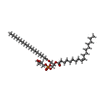[English] 日本語
 Yorodumi
Yorodumi- PDB-7rwj: afTMEM16 in C22 lipid nanodiscs with MSP2N2 scaffold protein in t... -
+ Open data
Open data
- Basic information
Basic information
| Entry | Database: PDB / ID: 7rwj | ||||||
|---|---|---|---|---|---|---|---|
| Title | afTMEM16 in C22 lipid nanodiscs with MSP2N2 scaffold protein in the presnece of Ca2+ | ||||||
 Components Components | Plasma membrane channel protein (Aqy1), putative | ||||||
 Keywords Keywords | LIPID TRANSPORT / TMEM16 / lipid scrambling | ||||||
| Function / homology |  Function and homology information Function and homology informationphospholipid scramblase activity / cortical endoplasmic reticulum / phospholipid translocation / chloride channel activity / voltage-gated calcium channel activity / chloride transmembrane transport / monoatomic ion transmembrane transport / membrane Similarity search - Function | ||||||
| Biological species |  | ||||||
| Method | ELECTRON MICROSCOPY / single particle reconstruction / cryo EM / Resolution: 3.5 Å | ||||||
 Authors Authors | Falzone, M.E. / Accardi, A. | ||||||
| Funding support |  United States, 1items United States, 1items
| ||||||
 Citation Citation |  Journal: Nat Commun / Year: 2022 Journal: Nat Commun / Year: 2022Title: TMEM16 scramblases thin the membrane to enable lipid scrambling. Authors: Maria E Falzone / Zhang Feng / Omar E Alvarenga / Yangang Pan / ByoungCheol Lee / Xiaolu Cheng / Eva Fortea / Simon Scheuring / Alessio Accardi /   Abstract: TMEM16 scramblases dissipate the plasma membrane lipid asymmetry to activate multiple eukaryotic cellular pathways. Scrambling was proposed to occur with lipid headgroups moving between leaflets ...TMEM16 scramblases dissipate the plasma membrane lipid asymmetry to activate multiple eukaryotic cellular pathways. Scrambling was proposed to occur with lipid headgroups moving between leaflets through a membrane-spanning hydrophilic groove. Direct information on lipid-groove interactions is lacking. We report the 2.3 Å resolution cryogenic electron microscopy structure of the nanodisc-reconstituted Ca-bound afTMEM16 scramblase showing how rearrangement of individual lipids at the open pathway results in pronounced membrane thinning. Only the groove's intracellular vestibule contacts lipids, and mutagenesis suggests scrambling does not require specific protein-lipid interactions with the extracellular vestibule. We find scrambling can occur outside a closed groove in thinner membranes and is inhibited in thicker membranes, despite an open pathway. Our results show afTMEM16 thins the membrane to enable scrambling and that an open hydrophilic pathway is not a structural requirement to allow rapid transbilayer movement of lipids. This mechanism could be extended to other scramblases lacking a hydrophilic groove. | ||||||
| History |
|
- Structure visualization
Structure visualization
| Structure viewer | Molecule:  Molmil Molmil Jmol/JSmol Jmol/JSmol |
|---|
- Downloads & links
Downloads & links
- Download
Download
| PDBx/mmCIF format |  7rwj.cif.gz 7rwj.cif.gz | 228.4 KB | Display |  PDBx/mmCIF format PDBx/mmCIF format |
|---|---|---|---|---|
| PDB format |  pdb7rwj.ent.gz pdb7rwj.ent.gz | 180.7 KB | Display |  PDB format PDB format |
| PDBx/mmJSON format |  7rwj.json.gz 7rwj.json.gz | Tree view |  PDBx/mmJSON format PDBx/mmJSON format | |
| Others |  Other downloads Other downloads |
-Validation report
| Summary document |  7rwj_validation.pdf.gz 7rwj_validation.pdf.gz | 861.3 KB | Display |  wwPDB validaton report wwPDB validaton report |
|---|---|---|---|---|
| Full document |  7rwj_full_validation.pdf.gz 7rwj_full_validation.pdf.gz | 880.4 KB | Display | |
| Data in XML |  7rwj_validation.xml.gz 7rwj_validation.xml.gz | 40 KB | Display | |
| Data in CIF |  7rwj_validation.cif.gz 7rwj_validation.cif.gz | 58.6 KB | Display | |
| Arichive directory |  https://data.pdbj.org/pub/pdb/validation_reports/rw/7rwj https://data.pdbj.org/pub/pdb/validation_reports/rw/7rwj ftp://data.pdbj.org/pub/pdb/validation_reports/rw/7rwj ftp://data.pdbj.org/pub/pdb/validation_reports/rw/7rwj | HTTPS FTP |
-Related structure data
| Related structure data |  24717MC 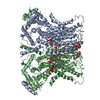 7rx2C 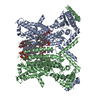 7rx3C 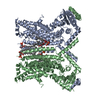 7rxaC 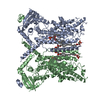 7rxbC 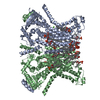 7rxgC  7rxhC M: map data used to model this data C: citing same article ( |
|---|---|
| Similar structure data | Similarity search - Function & homology  F&H Search F&H Search |
- Links
Links
- Assembly
Assembly
| Deposited unit | 
|
|---|---|
| 1 |
|
- Components
Components
| #1: Protein | Mass: 84616.859 Da / Num. of mol.: 2 Source method: isolated from a genetically manipulated source Source: (gene. exp.)  Strain: ATCC MYA-4609 / Af293 / CBS 101355 / FGSC A1100 / Gene: AFUA_4G02970 / Production host:  #2: Chemical | ChemComp-CA / #3: Chemical | ChemComp-PGW / ( Has ligand of interest | N | |
|---|
-Experimental details
-Experiment
| Experiment | Method: ELECTRON MICROSCOPY |
|---|---|
| EM experiment | Aggregation state: PARTICLE / 3D reconstruction method: single particle reconstruction |
- Sample preparation
Sample preparation
| Component | Name: afTMEM16 scramblase C22 lipid nanodiscs with MSP2N2 scaffold in the presence of Ca2+ Type: COMPLEX / Entity ID: #1 / Source: RECOMBINANT |
|---|---|
| Molecular weight | Experimental value: NO |
| Source (natural) | Organism:  |
| Source (recombinant) | Organism:  |
| Buffer solution | pH: 8 |
| Specimen | Embedding applied: NO / Shadowing applied: NO / Staining applied: NO / Vitrification applied: YES |
| Specimen support | Grid material: GOLD / Grid type: UltrAuFoil R1.2/1.3 |
| Vitrification | Instrument: FEI VITROBOT MARK IV / Cryogen name: ETHANE / Humidity: 100 % |
- Electron microscopy imaging
Electron microscopy imaging
| Experimental equipment |  Model: Titan Krios / Image courtesy: FEI Company |
|---|---|
| Microscopy | Model: FEI TITAN KRIOS |
| Electron gun | Electron source:  FIELD EMISSION GUN / Accelerating voltage: 300 kV / Illumination mode: OTHER FIELD EMISSION GUN / Accelerating voltage: 300 kV / Illumination mode: OTHER |
| Electron lens | Mode: OTHER |
| Image recording | Electron dose: 44.4 e/Å2 / Film or detector model: GATAN K3 (6k x 4k) |
- Processing
Processing
| Software | Name: PHENIX / Version: (1.14_3260:phenix.real_space_refine) / Classification: refinement |
|---|---|
| EM software | Name: SerialEM / Category: image acquisition |
| CTF correction | Type: PHASE FLIPPING AND AMPLITUDE CORRECTION |
| Symmetry | Point symmetry: C2 (2 fold cyclic) |
| 3D reconstruction | Resolution: 3.5 Å / Resolution method: FSC 0.143 CUT-OFF / Num. of particles: 31890 / Symmetry type: POINT |
| Refinement | Cross valid method: THROUGHOUT |
| Displacement parameters | Biso max: 83.15 Å2 / Biso mean: 40.2515 Å2 / Biso min: 19.52 Å2 |
 Movie
Movie Controller
Controller








 PDBj
PDBj

